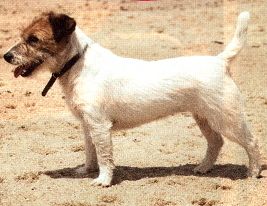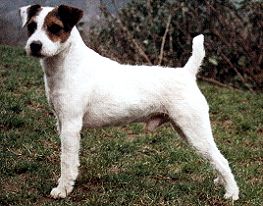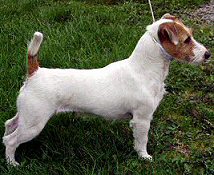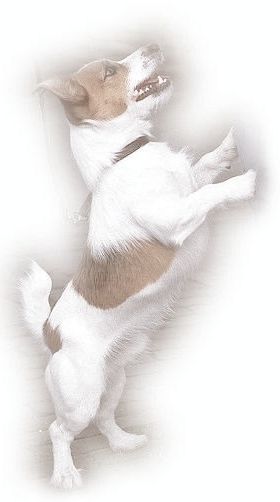|
The Jack Russell Terrier originated in England in the 1800’s due to the efforts of the Reverend John Russell. He developed a strain of Fox Terriers to suit his needs for a dog to run with his foxhounds and go to ground to bolt the fox and other quarry from their dens. Two varieties evolved with basically similar Standards except for differences, mainly in height and proportions. The taller, more squarely built dog is now known as the Parson Russell Terrier and the shorter, slightly longer proportioned dog, is known as the Jack Russell Terrier.
Country of Development: Australia Date of publication of the original valid standard: 25.10.2000 Utilization: A good working Terrier with ability to go to ground. An excellent companion dog. Classification
FCI: Group 3 - Terriers, Section 2 - Small Terriers, With working
trial IMPORTANT
PROPORTIONS: BEHAVIOUR/TEMPERAMENT: A lively, alert and active Terrier with a keen, intelligent expression. Bold and fearless, friendly but quietly confident. HEAD:
BODY:
LIMBS
COAT
SIZE
AND WEIGHT: FAULTS:
Any departure from the foregoing points should be considered a fault
and the seriousness with which the fault should be regarded should
be in exact proportion to its degree. However, the following weaknesses
should be particularly penalised: N.B.: Male animals should have two apparently normal testicles fully descended into the scrotum.
|
|
CHARACTER AND EXPLOITING
Russell terrier
is a true friend of a man. He barks at visitors but it is everything.
He embraces all visitors with enthusiasm: more people, more fun. Good
socialized Jack Russell terrier is a friend with yours but also other
children. These dogs are not oversensitive, they have sport nature
and they like games and fun - doesn't matter how crazy it is and how
long it takes.
Jack Russell terriers are always independent. It results from their original using - the dog has made decisions during the hunting in fox burrow not its owner. Therefore they need consequential training. They obey their owner not because they want to serve him but because they like it - they do it only for themselves. That's why it is necessary so that the training would be really incentive and interesting. Jacks hate boring exercises. On the other side too much forbearing or democratic orientated owners manage nothing with this race too; the dog does what it likes. It depends on the owner if he has lovely, cheerful, not complicated, sporting dog and people will envy it to him or if he has a dog which is known as the terrorizing jack Russell terrier. |
|
HISTORY of JACK RUSSELL TERRIER The Great Britain has a hunting tradition over centuries; its part is a hunt on fox. For this hunt was used hunting dogs, which traced up the fox and then they pursued it with loud barking. Hunters, usually on the horses, followed the dogs and they were able to shut the fox sometimes after hours of pursuing. Nevertheless it happened regularly that the fox hid itself to a burrow and nor the dog neither the hunters could catch it. At this moment terriers improved for this aim has appeared on the scene and hunters can send them to catch the fox in its hole. These terriers were very brave and zealous. They ran quickly towards the fox and barked at it so long that it has left its safety burrow. It was important so that a dog didn't bite the fox to death, it would be the end of the hunt, and it was not the aim. These dogs were called "working terriers". The fox terriers pertained to this group too.
Many hunters looked on the disappearing of their working terrier with sorrow. For work under the ground were terriers too big and also their character needful for hunting started to be worse. Hunters have dissociated partialy from exhibition dogs as their owners and have improved terriers suitable for hunt - often without pedigree. To these people pertained a man, who had a big effect on development of Jack Russell terrier - Pastor John Russell. This pastor had almost white, rough-haired, small dogs of good quality, on which we must not forget. Reverend John Russell was one of the oldest members of Kennel Club and he is up today known as the breeder of branch of fox terriers, which is good used for hunting - according to him called Jack Russell terrier. This branch is most roughhewn, primitiver form and has shorter legs than modern exhibition type. Around the year 1818 Jack Russel obtained from dairy-man Marston terrier bitch called "Trump". It has to be a bitch similar to fox terrier but she didn't have so short legs as today's Jack Russell terriers. He always has prefered white dogs with yellow signs. Russell reared short-heared terriers according to pattern "Trump", with long legs, which could follow the hunters during hunting. We could say that "Trump" was a founder of breeding of Jack Russell terrier. Though Russell was one of the founder of Kennel Club and till his deth he stayed its member, he has never exposed his terriers after the year 1869 and he hasn't let them registere into the race book of Kennel Club. During 60 years of his breeding activity he made a type of harsh dogs for hunting needs, which were able to chase out the fox faithfully from the lair, but they hadn't to kill it. These dogs were small; they didn't have more than 15 pounds. His dogs were mostly short-haired. Their hair has a structure of rough-haired puppy's hair. They had, as mentioned, longer legs than today's Jack Russell terrier on the continent. Jack Russell alone has built up his breeding very purposefully. His entries are clear and authentic. When he established his breeding, he made crossing of other blood only rarely. The speech is about dog "Old Jack", working terrier, which obtained a lot of awards on the exhibitions, from breeding of kpt. Percy Williams. Russell used this dog for his breeding in 60´s. Since 1880 different dogs are exposed, of which Jack Russell terriers are ancestors, for example in 1880 "Carlise Tack" daughter of Jack Russell's bitch "Fuss". The next successful bitch was "Pussy", it was sold by Mr. Wootton to a breeder, exhibitor and arbitrator S. E. Shirley for a fantastic price 40 L. (in this time the annual salary of a pastor was 60 L.!). After Russell's death his dogs were dispersed. A big part of them came to Mr. C. H. Basset from Watermonth Castle by Ilfracombe. The dogs have had shorter legs already than first dogs of Jack Russell and they had a little shorter snout. Some names and stories were saved. We can hear about acts of dogs called "Tip", "Nelson" or "Nettle" and so on. Even if this breed can be proud on his long history, it took a long time than cynology has started to engage in it. We can not be surprised at it, because the breeder of Jack Russell terriers didn't want to acknowledge these dogs as a breed at the beginning. Acknowledgement would mean that these dogs would get to exhibitions environmental. Breed standard inseparably connected with refining of appearance led to concessions from original talent to work and working skill by many working dogs. The lovers of working Jack Russell terrier considered it as unacceptable. Today Jack Russell terrier is recognized by FCI meanwhile and it exists its standard edited under FCI 14. december 2000 (number 345). |







